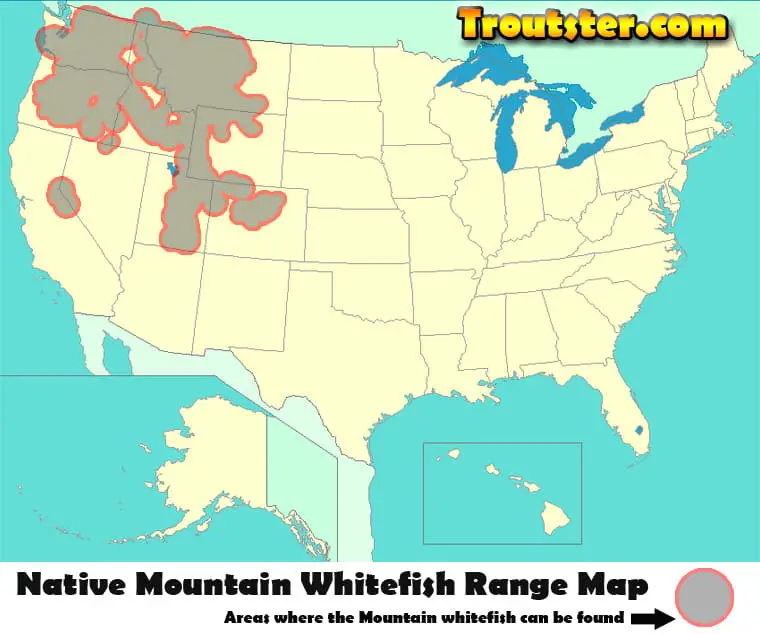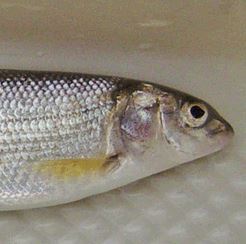This post was last updated on August 28th, 2021 at 01:43 pm
Mountain Whitefish are a very common species in the Western US. They are not known for their fighting prowess, and they are certainly not a beautiful species. One thing that can be said about these fish is that they are eager to eat trout flies. They are often schooled up in large numbers in many trout streams aggressively feeding on any and all available nymphs. Mountain whitefish are actually a close relative to the arctic grayling and a cousin to trout.
The Mountain Whitefish
Also known as: Prosopium williamsoni. Other common nick names include: Whitey, Mountain Bonefish and Bugler’s

Where to Find the Mountain Whitefish
This species is found in areas in the states of Washington, Idaho, Montana, Utah, Colorado, Wyoming, Oregon, California and Nevada. See the map below for more detailed information.

Mountain whitefish were introduced into the Cache la Poudre river and roaring fork in Colorado in the 1950’s and they have a successful population to this day. They were also planted in Michigan in the 1920’s, but this population was never able to gain a foothold and they are currently non existent in Michigan. There is a species of whitefish in MI, but it is an entirely different species. It is known as the lake whitefish (Coregonus clupeiformis).
In many areas the mountain whitefish will outnumber trout significantly. There are populations of this species as high as 15,000 fish per mile in several areas.
How to Catch Mountain Whitefish – Mountain Whitefish Fly Fishing
Mountain whitefish fly fishing can be an exciting time. They will be happy to take your nymphs and even occasionally pop up to eat dry flies. They tend to be found in large schools, typically in slower water at the lower end of riffle water and will commonly stack up on current seams in the same places you would expect to find trout. Whitefish will often sit in schools with various species of trout, so you will often catch a mixed bag of whitefish and trout in the same spot.
It is very common for trout anglers to get upset when they find out that they have a mt. whitefish on their line instead of the prized trout. Most whitefish are not great fighting fish compared to most trout species. They have a certain style of fighting and you can usually tell when you have one hooked by the smaller head shakes and lack of pulling power.
These fish are amazingly talented at fitting even large nymphs into their small mouths at fast river speeds. The shape of the whitefish’ mouth would lead you to believe they eat most food directly off the bottom of the river, however that is often not the case. It is very common for whitefish to come up and attempt to eat dry flies of any size.
If you are using standard fishing gear for mountain whitefish, you can usually be successful with drifting a small leafworm and bobber through likely habitat. A big bell sinker with a size 10-12 snelled hook will also work well in faster water for stationary fishing.
In this video I am catching mountain whitefish with fly fishing gear. Even in extremely dirty water I manage to get a couple.
Mountain White Fish Spawning Habits
This species will spawn in the fall and early winter. They don’t build nests like their cousins trout, they simply broadcast eggs on gravel. This species will typically reach breeding maturity at 3 years of age. The female mountain whitefish will lay as many as 4,000 eggs during breeding season.
Are Mountain Whitefish Good to Eat?
This fish species is absolutely delicious to eat if you smoke them or fry them in butter or oil. The limit for mountain whitefish in Idaho is 25, so if you are looking for the perfect fish to have a big fish fry, the mountain whitefish is just what you should be targeting.
This spring I went out in search of some mountain whitefish to fry up. I caught a couple and brought them home. They were as good as any fish I’ve ever eaten! Read about if whitefish are good to eat and watch the video of how I go about cleaning and cooking mountain whitefish here.

